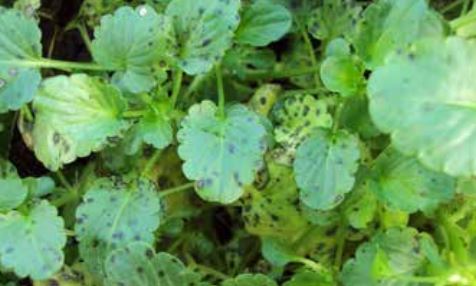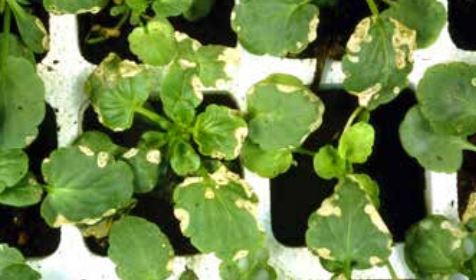Please click here to access the main AHDB website and other sectors.
- Home
- Knowledge library
- Ramularia leaf spot of pansy and viola
Ramularia leaf spot of pansy and viola
Learning how to recognise ramularia leaf spot and understanding its basic biology will help you choose the best control strategies and minimise the risk of crop damage and fungicide resistance.
This information was last updated in 2014.
Go back to the main page: Controlling leaf and root diseases of pansy and viola
Two species of Ramularia (R. lactea and R. agrestis) have been reported causing leaf spotting on pansy and viola.
Both species of the fungus can spread rapidly through crops but are thought to be host-specific so shouldn’t pose a threat to other plant genera on the nursery.
Ramularia leaf spot symptoms
Initial symptoms usually occur as distinct, small dark leaf spots often on the older lower leaves of plants. R. lactea tends to produce small, purplish-brown ‘greasy’ spots enlarging with age (see Figure 1).
R. agrestis on the other hand tends to cause small tan coloured spots initially, which begin to merge or coalesce causing a light brown necrosis which is ‘papery’ or ‘scorched’ in appearance (see Figure 2).
These symptoms can be mistaken for damage caused by chemical scorch or stress as a result of under-watering.
It is possible for both symptom types to occur in the same crop. Plant clinic diagnosis is usually necessary for accurate identification of the disease.
 Dr G M McPherson
Dr G M McPherson
Figure 1. Small purplish-brown, 'greasy' leaf spots are usually associated with infection by Ramularia lactea.
 Dr G M McPherson
Dr G M McPherson
Figure 2. Characteristic 'papery, scorch-like' leaf spots are more often associated with infection by Ramularia agrestis.
Disease development, spread and survival
The pathogen is usually most prevalent during cool, wet weather and is most commonly found during the autumn.
The fungus produces and liberates a large number of spores from infected leaves. These are dispersed on air currents or by water splash. The pathogen is likely to survive on infected plants including leaf litter.
Controlling ramularia leaf spot
Crops need to be monitored regularly, especially during the early stages of production, for the tell-tale signs of leaf spotting on the older leaves.
Where found, early intervention with a suitable fungicide is advisable to help prevent epidemic development.
There is a risk of resistance development in the pathogen population so an alternating fungicide programme is advisable.
Useful links
Download the original PDF version of this information from 2014
Read about bacterial diseases of protected ornamentals and possible control measures
Authors
Original authored by Andrew Jackson, Martin McPherson, and Wayne Brough.

